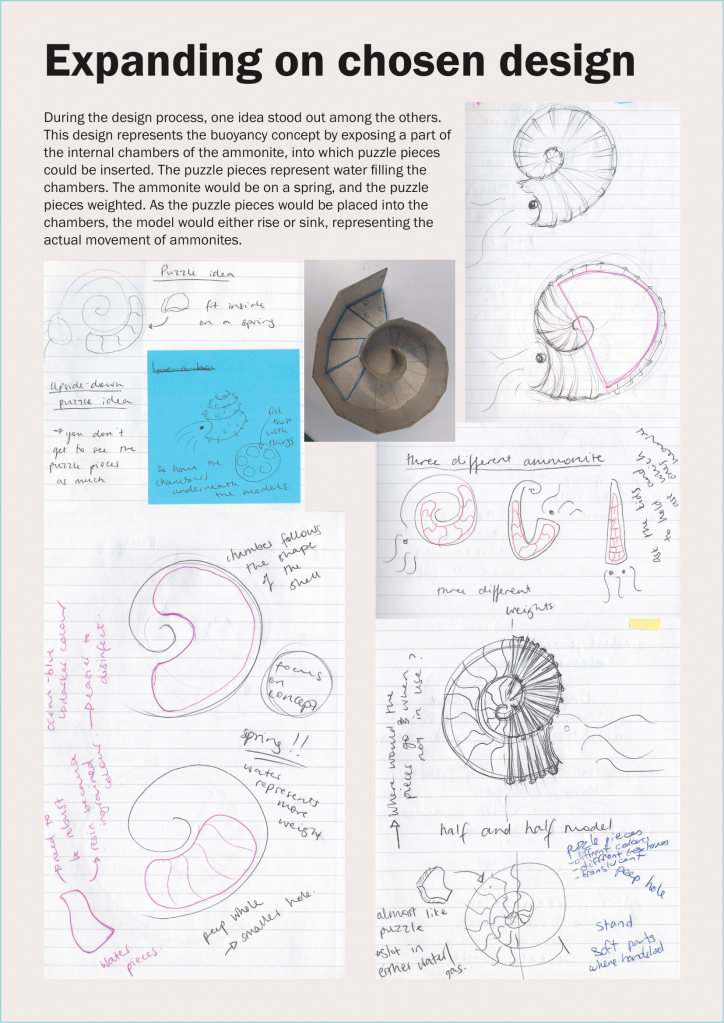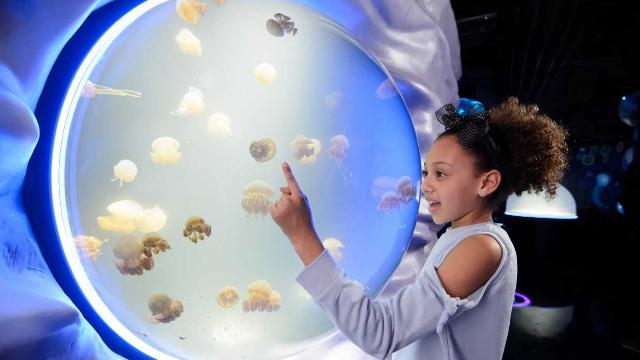For the first few weeks of the project I was always prompting myself to think more broadly about potential designs for the model. After a while, I realised I kept coming back to the same idea, which I eventually decided to explore in more detail.
That said, I believe thinking broadly before deciding to focus on one idea in particular, helped me to consider far more perspectives than I would have otherwise. I believe it had an impact on certain elements of the final design, which were inspired by features I explored during the earlier stages of the design process.
What is the idea I chose to explore further?
Puzzles! This design represents the concept of ammonite buoyancy using ‘puzzle pieces’ that slot into the chambers of the ammonite.
These puzzle pieces represent the water that would have gone into the chambers of the ammonite to make them either rise or sink. The ammonite would be on a spring and the puzzle pieces would be weighted. Placing the puzzle pieces inside the chambers would make the model sink by increasing its weight.
The model would also be placed on a spring, which would make it rise again once the puzzle pieces were removed. This represents the actual way that ammonites used water to influence their buoyancy system – they would fill the chambers with water to sink and take the water away to rise.
Why did I choose to focus on this idea?
The buoyancy system is quite an abstract concept and the model must be able to portray it in an accessible way for the audience. I believe the puzzle idea represents this in the clearest way from all my ideas. Additionally, I really enjoyed the interactive aspect – puzzles are games that most of us have experienced before, which makes them more relatable and simpler to interact with.
I also liked how there was the potential of adding an element of narrative to the design – I could develop the outside of the shell and the soft parts to give animalistic context to the concept. Elements such as texture of the outside shell, colouration, and positioning of the tentacles, could add a story to the creature as it would reflect the way they led their lives. To achieve this, I researched more into what could have been the colouration of the shell, and what the soft parts of the creature looked like.
What were the main elements of the design I considered during the process?
- Shell
- Soft parts (squid)
- Chambers
- Puzzle pieces
- Mechanism
- Stand
Shell
Some of the main questions I explored:
- What shape should the shell be?
Although ammonite shells took many different shapes, in the Kimmeridge area only ones with tight spirals were found. I briefly looked at how I could incorporate different shapes of shells into my design, but decided that due to the values of the museum, the tight spiral would be best. The Etches Collection places a strong emphasis on its local area, where all fossils from the museum were uncovered by Dr Steve Etches.
- What amount of detail would I include on the outside of the shell?
I had to decide between going for a more realistic look, or more of an illustrative portrayal. I decided that hyperrealism on the outside shell would not fit the rest of the model – the exposed chambers abstract the look of the model. Therefore, I decided that perhaps a more illustrative look would be best.
- What colour were their shells?
There is not a lot of data in this area considering ammonites. Experts hypothesise that the colouration of their shells could have ranged anything from pure white to orange with brown streaks. One thing that could have had a big influence on this would have been the environment that the ammonite lived in. This will be explored further in my upcoming post.
Soft parts
These include body parts such as the head, tentacles, and eyes.
Some of the main questions I explored:
- What did the soft parts of the ammonite look like?
There have been no fossils found of the soft parts of ammonite. Therefore, experts can only theorise what these looked like. Many look to sister groups of the ammonite – the nautilus and cuttlefish – for answers.
Chambers
Some of the main questions I explored:
- How many chambers should be exposed?
This model depends on part of the outside of the shell being cut apart to expose the chambers inside. The size of this area would dictate how many chambers and puzzle pieces would be in the model. I had to consider this in relation to the audience, and the amount of times they might want to interact with the model before their attention is lost.
- Where should the shell be exposed?
The placement of the exposed chambers was also important to consider. As the size of the chambers decreases the closer to the centre of the spiral you get, this would impact the size of the puzzle pieces. This would be important to the model, because the puzzle pieces would have to be big enough to facilitate enough weight so that the model could be weighted down enough to sink. The puzzle pieces would also have to be big enough to be handled easily.
Additionally, I also had to be mindful of the fact that the beginning of the shell spiral houses the soft tissue of the ammonite (such as the head and internal organs). This means that the shell could not be exposed in this area, as scientifically, there would be no chambers in that place.
- Half and half model?
The shell would be split in half – equal amount of chambers covered and exposed. This could either be vertical or horizontal.
- How realistic should the chambers be? Jagged/natural/abstracted?
Exploring this question I was juggling two opposing ideas – realistic or more abstracted chambers. The former would mean the chambers would be far more complex, as realistic chambers inside ammonite shells curve and connect with each other – they do not follow a simple pattern. While this is beautiful, it will be too complex to make a puzzle out of. Therefore, a more abstract look might be more appropriate, as it would simplify the chambers, which would make the puzzle pieces easier to slot in and out. This will increase the effectiveness of the interactive element of the model.
Puzzle pieces
Some of the questions I explored:
- How many?
Related to previous question on ‘How many chambers should be exposed?‘
- What material?
I have been investigating using metal, resin, or silicon for the puzzle pieces. The metal pieces will provide the most weight to the model but might take the longest time to make. The resin might be the fastest material to work with, and I could add metal powder to the resin to increase its weight. Silicon would add an interesting tactile element that could also boost the immersion of the model. It would be the closest in imitating a liquid, as silicon is much softer than any of the other materials I was considering. Silicon might not add enough weight for the ammonite to be weighted down enough.
- What texture?
Rough, smooth, matte, or glossy.
- What colour?
These puzzle pieces could be any colour, from something imitating fossils to symbolising water. I believe blue would be the best choice as it links the closest with the concept I am aiming to represent.
The shade of the blue might also be influential – I would like to stay away from very light/pastel colours, but dark blue would also not be a good choice as it represents deep water. The ammonite most likely occupied more shallow waters, so perhaps a mid-blue might be more appropriate.
- Magnets?
In order to increase ease of usage, I could place magnets in the chambers and puzzle pieces. This will not only increase the weight of the model which will aid the mechanism, it will also make sure that the puzzle pieces will stay in the chambers.
Mechanism
This will be detailed in an upcoming post. Stay tuned!
Stand
Some of the questions I explored:
- Vertical or horizontal?
A vertical stand and background would be more appropriate due to the nature of the model – it represents a concept of up-and-down movement.
- Curved or straight?
The background could be straight like a plank or curved, like the glass in some aquarium exhibits. Curving the background might make the model more dynamic, as it could relate the ammonite to its environment when it was alive.
- Pipe or tubing?
The ammonite could be attached to a spring which would be hidden inside a pipe. This would give an industrial/raw look, which insinuates the organic nature of palaeontology. It would also not take the focus away from the model and concept. Easy to transport. Easy to set up. Doesn’t take much space.
How did I explore these ideas?
While a large part of my design process was done through drawings and sketches both on paper and digital, I explored parts of this design through physical maquettes. These were made from greyboard and clay.
The greyboard maquette helped me to explore:
- The size of the overall model
- The shape of the spiral and how it spirals into smaller chambers as it goes internally
- What the chambers look like – made me decide on a more organic look that wasn’t so jagged
The clay maquette helped me explore these ideas:
- The size of the overall model
- The shape of the shell – how one part of the spiral overlays the other
- The look of the ridges on the outside of the shell
- How much of the shell to expose
- What would the chambers look like inside
Overall, the second stage of this design process focused more intently on investigating and bench testing different elements of one idea. Supporting my ideas was research on ammonites and on a variety of materials and techniques. Sketches were explored further by physical maquette models, and vice versa.
I had a lot of fun with this stage, especially while sculpting the shell of the ammonite! I am looking forward to studying the intricate details of the shells further during the sculpting stage of the model.
Stay tuned for an upcoming post portraying my final design.


































